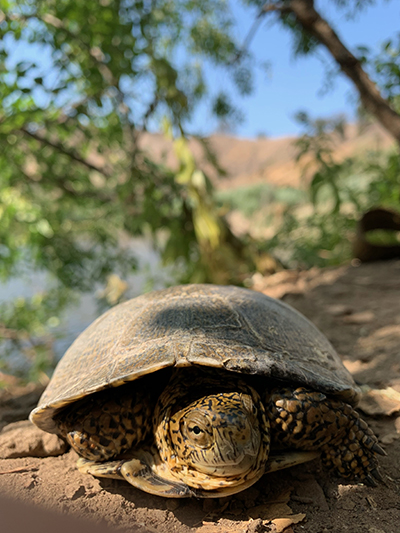Basking in the Sun
By Cori Carlson, Administrative Coordinator

Release back to the wild
Photo by Spencer Orloff, finder
A California State Park employee brought a female adult Western Pond Turtle to the California Wildlife Center in late June of this year. Her top and bottom shells were cracked, chunks of shell were missing, and she showed signs of an infection. The ranger found the turtle in the road with injuries consistent with a sudden impact trauma, such as being hit by a car. This was CWC’s first turtle patient of the year.
Western Pond Turtles are California’s only native freshwater turtle. The adults grow up to 6 to 8 inches in length, but the baby turtle is only about the size of a quarter. Ranging from the Puget Sound in Washington to Baja California in ponds, streams, lakes and wetlands, these medium-sized turtles have a brown or black upper shell with light specks of color. Their lower shell typically is black and yellow. They often are spotted near water, but they also need places to bask in the sun. Sometimes, the turtles stack themselves on top of one another to keep warm.
After the turtle’s injuries were cleaned and the damaged tissue and non-vital parts of the shell removed, our veterinarian prescribed anti-inflammatory medication and antibiotics to help the infected area heal.
CWC always works hard to provide our patients with an environment that closely resembles their home. In this case, our technicians set up a turtle pond outside our intensive care unit. Each day the turtle was taken out to her pond and each evening she would return to her enclosure furnished with heat lamp in the ICU. Her outdoor retreat was especially important because this species of turtle only eats underwater. They are omnivores, eating insects, fish, tadpoles, frogs, algae, lily pads, tule and cattail roots.
While birds, fish and bullfrogs are the main predators of Western Pond Turtles, they also face other threats such as habitat destruction, disease, fire, flooding, and droughts. The loss of only a few adults can have a significant impact on the population, because the female turtles do not reach maturity until close to 10 years of age.
Over time, new, healthy tissue grew repairing the damage to the shells and allowing the turtle to return to the wild 22 days after being admitted. The same California State Park employee released the turtle back into the Santa Monica Mountains to bask in the sun, safely away from the roads.
